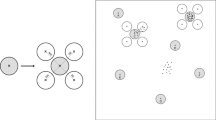Abstract
A number of different types of edge effects on experimental plots are defined, and it is shown that they are frequently important in agroforestry experiments. Methods of eliminating edge effects, either at the design or the analysis stage, are described. Computer simulations, based on uniformity data, are used to investigate the efficacy of neighbour-balanced designs, with and without neighbour terms, for reducing the problem of neighbour effects between different treatments. It is concluded that, while neighbour-balanced designs may be useful in certain situations or in combination with other methods, it is preferable to eliminate edge effects by using adequate guard rows. Recommendations are therefore made concerning the correct use of guard areas in agroforestry experimentation.
Similar content being viewed by others
References
Bailey RA (1984). Quasi-complete Latin Squares: construction and randomization. Journal of the Royal Statistical Society B 46: 323–334
Bhali, MA, Day AD, Tucker Henry, Thomson RK and Massey GD (1964) End-border effects in irrigated barley yield trials. Agronomy Journal 56: 346–348
Dyke GV (1988) Comparative experiments with field crops. 2nd Edition. Charles Griffin, London
Dyke GV and Shelley CF (1976) Serial designs balanced for effects of neighbours on both sides. Journal of Agricultural Science, Cambridge 87: 303–305
Haines WB, Crowther EM and Thornton GJ (1954) Manuring Hevea V: some long-term effects in the Dunlop (Malaya) experiments. Empire Journal of Experimental Agriculture 22: 203–210
Holstener-Joergensen H and Kromann H (1975) Edge effects in fertilizer experiments with 77-year old Norway Spruce in Gludsted plantation and with 83-year old Norway Spruce in Borbjerg plantation. Forstlige Forsoegsvaesen i Danmark 34: 279–292
Jensen NF and Federer WT (1964) Adjacent row competition in wheat. Crop Science 4: 641–645
Kempton RA and Howes CW (1981) The use of neighbouring plot values in the analysis of variety trials. Applied Statistics 30: 59–70
Lockwood G and Martin KJ (1976) The use of whole plot data from progeny trials with cocoa (Theobroma cacao L.) in Ghana. Journal of Horticultural Science 51: 353–358
McDonald GE and Peck NH (1976) Border effect in a long term fertility experiment. Agronomy Journal 68: 530–532
Pearce SC, Clarke GM, Dyke GV and Kempson RE (1988) A Manual of Crop Experimentation. Charles Griffin, London
Street AP and Street DJ (1987) Combinatorics of Experimental Design. Oxford University Press
Tolhurst JAH (1977) The role of guard rows in field experiments. Tea in East Africa 17: 23–29
Vernon AJ (1968) Edge effects in a cocoa shade and manurial experiment. Journal of Horticultural Science 43: 147–152
Author information
Authors and Affiliations
Rights and permissions
About this article
Cite this article
Langton, S. Avoiding edge effects in agroforestry experiments; the use of neighbour-balanced designs and guard areas. Agroforest Syst 12, 173–185 (1990). https://doi.org/10.1007/BF00123472
Issue Date:
DOI: https://doi.org/10.1007/BF00123472




